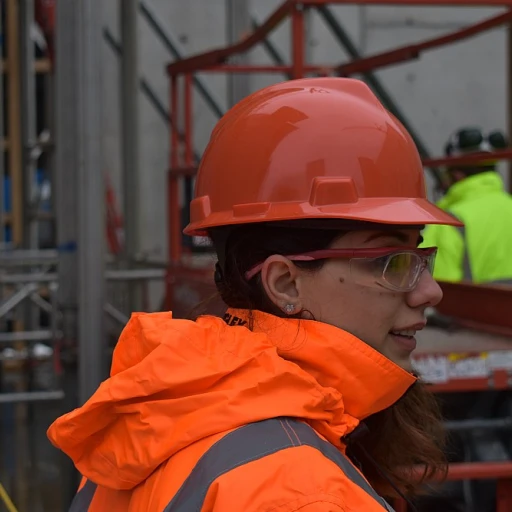Understanding the Importance of Employee Recognition
The Role of Employee Recognition in the Workplace
Employee recognition is a powerful tool in fostering a positive work environment and promoting employee engagement. By appreciating the hard work and dedication of employees, companies can align the workforce with their core values and goals. When employees feel valued and appreciated, they are likely to be more motivated and committed to the organization. Creating a culture of recognition is not just about giving rewards but about embedding appreciation into the organization’s DNA. This can contribute to a workplace culture that encourages employees to recognize the contributions of their peers, thereby strengthening team dynamics and enhancing the overall peer recognition.Advantages of Effective Employee Recognition
- Boosts Employee Engagement: Recognizing employees' efforts and accomplishments helps them feel engaged and connected to the company.
- Enhances Employee Satisfaction: Regular appreciation can make employees feel happier and more satisfied with their roles, leading to reduced turnover.
- Strengthens Organizational Values: Integrating a recognition program with the company values ensures that the culture appreciation resonates throughout the organization.
- Encourages Positive Behavior: By highlighting desirable behaviors and achievements, recognition programs can reinforce the actions that align with the company’s strategic objectives.
Key Elements of a Successful Recognition Program
Identifying the Building Blocks of Recognition
To successfully institute a recognition program, first define the key elements that will hold it together. A well-structured program begins with clear objectives aligned with company values and goals. The purpose extends beyond mere acknowledgment; it's about fostering a positive work environment that boosts employee engagement and nurtures a culture of appreciation. Employees should feel valued and recognized for their contributions, promoting both individual and team morale. By actively recognizing employees, companies can enhance the workplace culture and increase overall satisfaction.Balancing Formal and Informal Recognition Methods
Balance is crucial in designing a recognition program. Implement a blend of formal and informal recognition to cater to varied preferences within the organization. Formal programs may include rewards, employee appreciation events, and structured peer recognition, while informal may involve verbal acknowledgment or spontaneous acts of appreciation. Consider developing templates that prompt consistent recognition efforts across departments. Recognition templates can help ensure fairness and transparency, making it easier for managers and peers to contribute. This approach enhances the program’s impact on employees' perception of being appreciated.Embedding Recognition into the Workplace Culture
Integrate recognition into the organization's core values, turning it into a routine yet meaningful practice. Encouraging peer recognition can amplify the sense of belonging and camaraderie within teams. This involvement goes a long way in fostering an inclusive work culture where everyone feels their hard work is acknowledged. Clearly outline a policy for the recognition program that highlights the criteria and processes. Employees should clearly understand how to engage with the program and its benefits, promoting transparency and comfort in participating. A well-communicated programs policy will ensure engagement and sustainability of the initiative over time. Discover ways to boost employee satisfaction through effective HR communication, which further strengthens recognition efforts.Designing Your Employee Recognition Program Template
Structuring an Employee Recognition Blueprint
Constructing an exemplary employee recognition template is a pivotal step towards fostering a positive work environment. The template serves as a foundation that reflects the core values and culture of the organization while facilitating effective recognition practices. To ensure employees feel valued and appreciated, consider the following elements when designing your recognition blueprint:
- Company Values Alignment: Ensure the recognition program mirrors the company's values and highlights behaviors that contribute to accomplishing organizational objectives. This alignment encourages employees to embody these qualities.
- Diverse Recognition Methods: Incorporate a range of recognition methods such as verbal appreciation, peer recognition, formal rewards, and team celebrations. This diversity caters to different preferences and ensures every employee feels appreciated for their contributions.
- Clear Policies and Guidelines: Develop a comprehensive policy that outlines the criteria for recognition, including who can initiate the recognition and how frequently it can occur. This clarity helps maintain consistency and transparency in the recognition process.
- Incorporation of Rewards: While verbal and peer recognition are significant, adding tangible rewards can enhance motivation. Rewards should be meaningful and align with employee preferences to reinforce the recognition's impact.
- Customization Options: Recognize that a one-size-fits-all approach may not be effective. Allow for customization in recognition programs to tailor the experience to individual employee needs and preferences.
- Feedback Mechanism: Integrate a system for collecting feedback from employees to continually evolve the recognition program. This feedback can provide valuable insights into what drives employee engagement and appreciation in your organization.
With these key elements incorporated into your recognition template, set the stage for implementing a program that not only recognizes hard work but also enriches your workplace culture. By doing so, you'll create an environment where employees feel genuinely valued, promoting deeper employee engagement and satisfaction.
Implementing the Recognition Program
Steps to Successfully Roll Out Your Employee Recognition Program
Implementing a recognition program is a critical phase where companies can truly harness the power of appreciation, driving both employee engagement and the cultural shift towards a positive work environment.- Draft a Clear Policy: Start by articulating a comprehensive policy that outlines the purpose of your recognition program. This should include how it aligns with your company values and the expected outcomes. Transparency in policy ensures that employees understand how recognition plans operate, what behaviors get rewarded, and who is eligible for these recognitions.
- Leverage Peer Recognition: Incorporate peer recognition into your organizational strategy. This can be achieved by creating avenues where team members can recognize each other’s hard work and contributions. Peer recognition not only amplifies a feeling of camaraderie but also reinforces organizational values across the board.
- Incorporate a Recognition Template: Develop a consistent recognition template that can be utilized by managers and peers alike. This template should facilitate a straightforward process that makes recognizing employees simpler and quicker, ensuring that no contribution goes unnoticed.
- Training and Communication: Ensure that both management and employees are trained on the use of the recognition program. Organize workshops or training sessions that explain the process and the essence of the recognition culture you are striving to build.
- Launch with Enthusiasm: Introduce the program with a kick-off meeting or an internal campaign that excites the team. Highlight stories and examples of recognition, making it clear how the program aligns with the broader culture appreciation goals. Enthusiastic presentations of employee recognition ideas can foster buy-in and widespread acceptance across the organization.
- Monitor and Adjust: Establish key metrics for monitoring the initial rollout, and be prepared to make adjustments as necessary. Effective evaluation enables an organization to determine if the recognition program is on track to meet its goals. Regular feedback from the team can also help refine the process over time.
Evaluating and Improving the Program
Measuring the Impact of Your Recognition Program
Once your employee recognition program is in place, evaluating its effectiveness is crucial. This process not only helps in understanding how well the program is performing but also guides necessary adjustments to better align with company values and employee expectations. Here are some key aspects to consider:
- Feedback Collection: Regularly gather feedback from employees through surveys or focus groups. This will provide insights into how employees feel about the recognition they receive and whether it aligns with their contributions and hard work.
- Engagement Metrics: Analyze employee engagement levels before and after the implementation of the recognition program. An increase in engagement is often a strong indicator that employees feel appreciated and valued.
- Peer Recognition: Assess the frequency and quality of peer recognition. A culture of appreciation among peers can significantly enhance the overall work environment and workplace culture.
- Alignment with Core Values: Ensure that the recognition program reflects the organization's core values. This alignment helps in fostering a positive work culture and reinforces the company’s mission.
- Program Participation: Monitor the participation rates in the recognition program. High participation rates typically indicate that employees are engaged and find the program rewarding.
Making Continuous Improvements
Improving your recognition program is an ongoing process. Based on the feedback and data collected, make necessary adjustments to the program. This could involve updating the recognition template, modifying the rewards system, or revising the programs policy to better suit the needs of your employees.
Regularly updating the program ensures it remains relevant and effective, helping employees feel valued and appreciated for their contributions. By continuously refining the program, your organization can maintain a positive work environment and enhance overall employee engagement.
Overcoming Challenges in Recognition Programs
Addressing Common Hurdles in Employee Recognition
Implementing an employee recognition program can be a rewarding endeavor, but it’s not without its challenges. Organizations often face obstacles that can hinder the effectiveness of their recognition programs. Understanding these challenges is crucial to creating a positive work environment where employees feel valued and appreciated.
Navigating Budget Constraints
One of the primary challenges is budget limitations. Companies may struggle to allocate sufficient funds for rewards and recognition. To overcome this, consider cost-effective alternatives such as peer recognition initiatives, where team members recognize each other’s contributions. This approach not only saves costs but also fosters a culture of appreciation and collaboration.
Ensuring Consistency and Fairness
Consistency and fairness are critical to the success of any recognition program. Employees need to feel that recognition is based on merit and aligns with the company’s core values. Establishing clear criteria and a transparent policy can help in maintaining fairness. Regularly reviewing the recognition template can ensure it remains aligned with organizational goals and values.
Overcoming Engagement Barriers
Engagement is another hurdle. Employees might not participate actively in recognition programs if they don’t feel a connection to the company’s values or if the programs feel forced. To boost engagement, tailor the recognition program to reflect the unique culture of your organization. Encourage employees to contribute ideas for recognition, making them feel more involved and valued.
Maintaining Momentum
Once a recognition program is in place, maintaining momentum can be challenging. It’s essential to keep the program dynamic and evolving. Regular feedback from employees can provide insights into what’s working and what needs improvement. This feedback loop helps in refining the program and keeping it relevant to the employees’ needs.
In conclusion, while challenges in recognition programs are inevitable, addressing them proactively can lead to a more engaged and motivated workforce. By focusing on budget-friendly solutions, ensuring fairness, boosting engagement, and maintaining momentum, companies can create a recognition culture that truly appreciates and values employee contributions.








